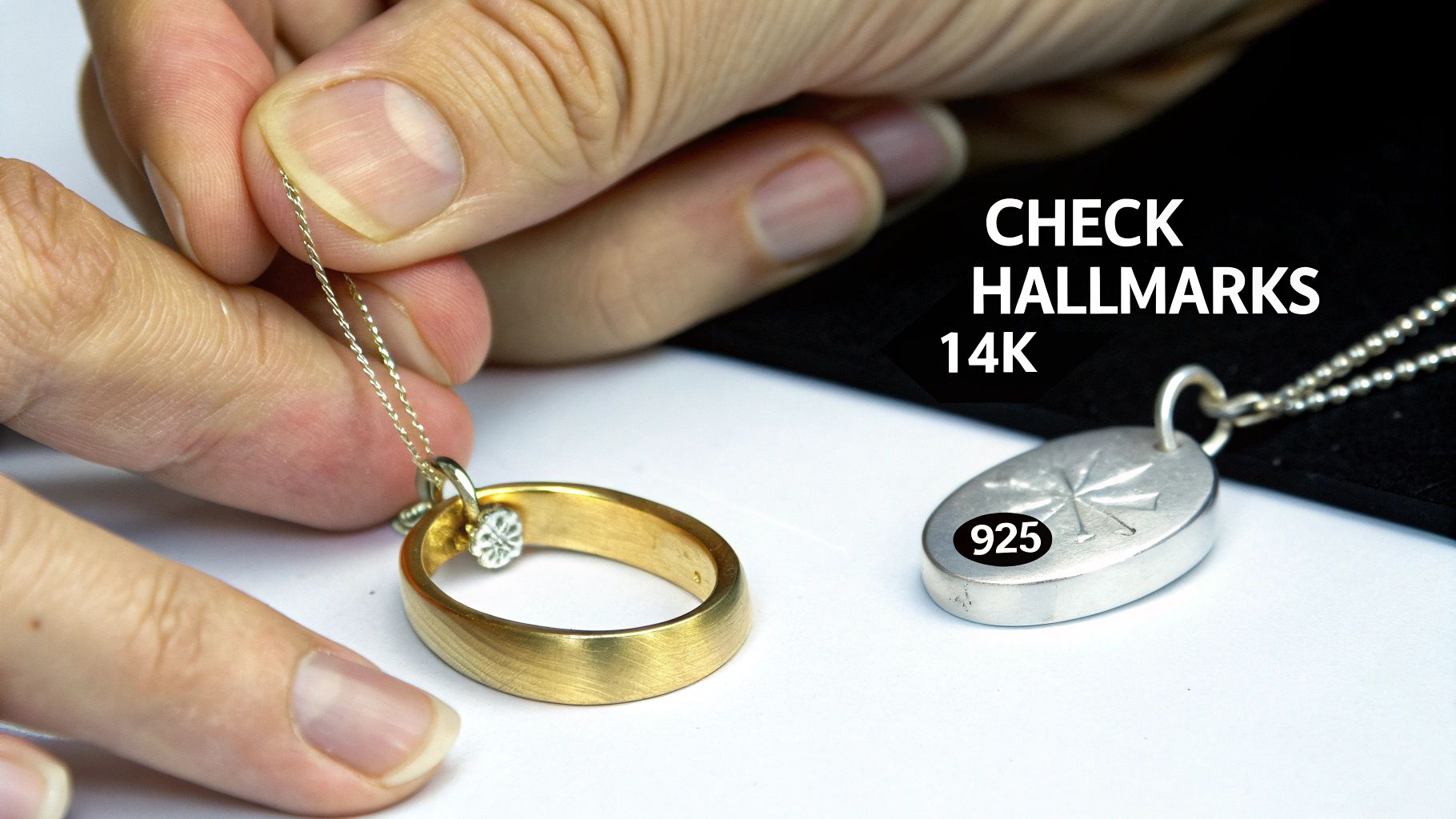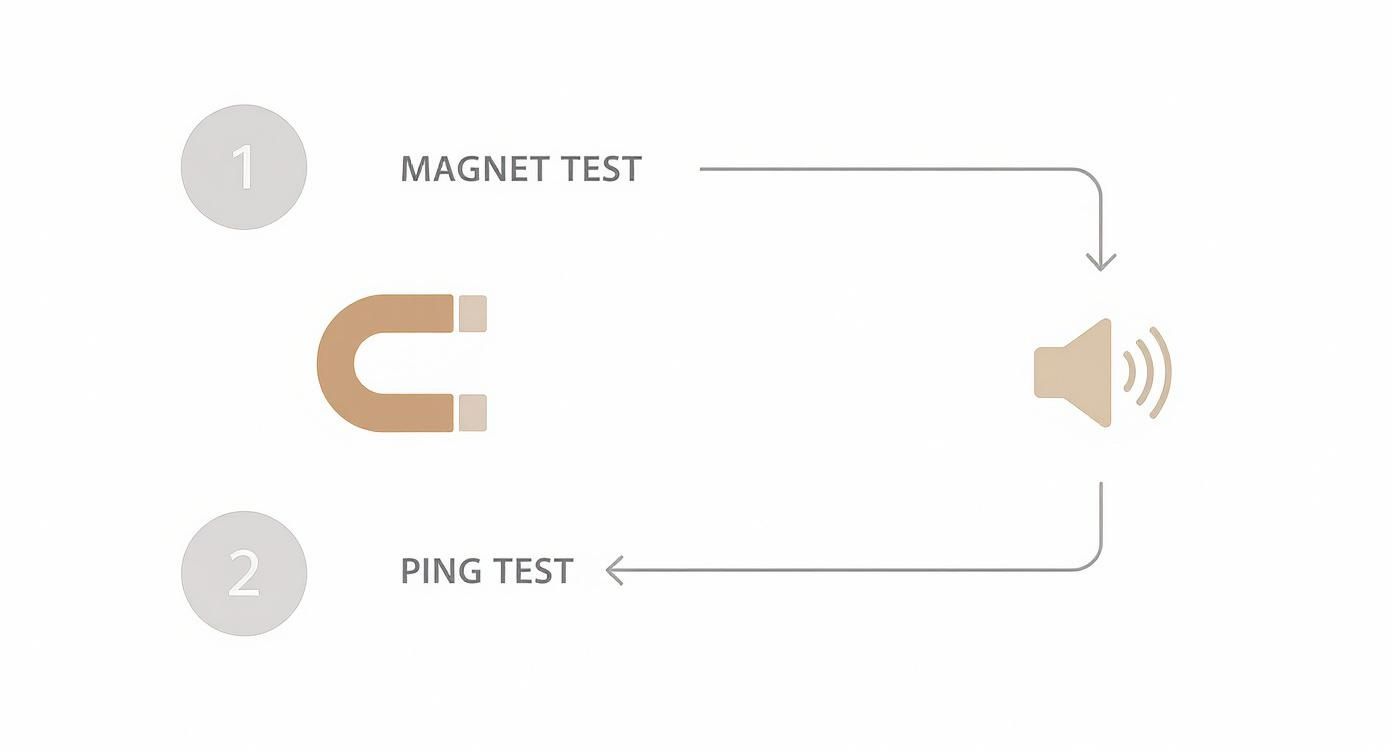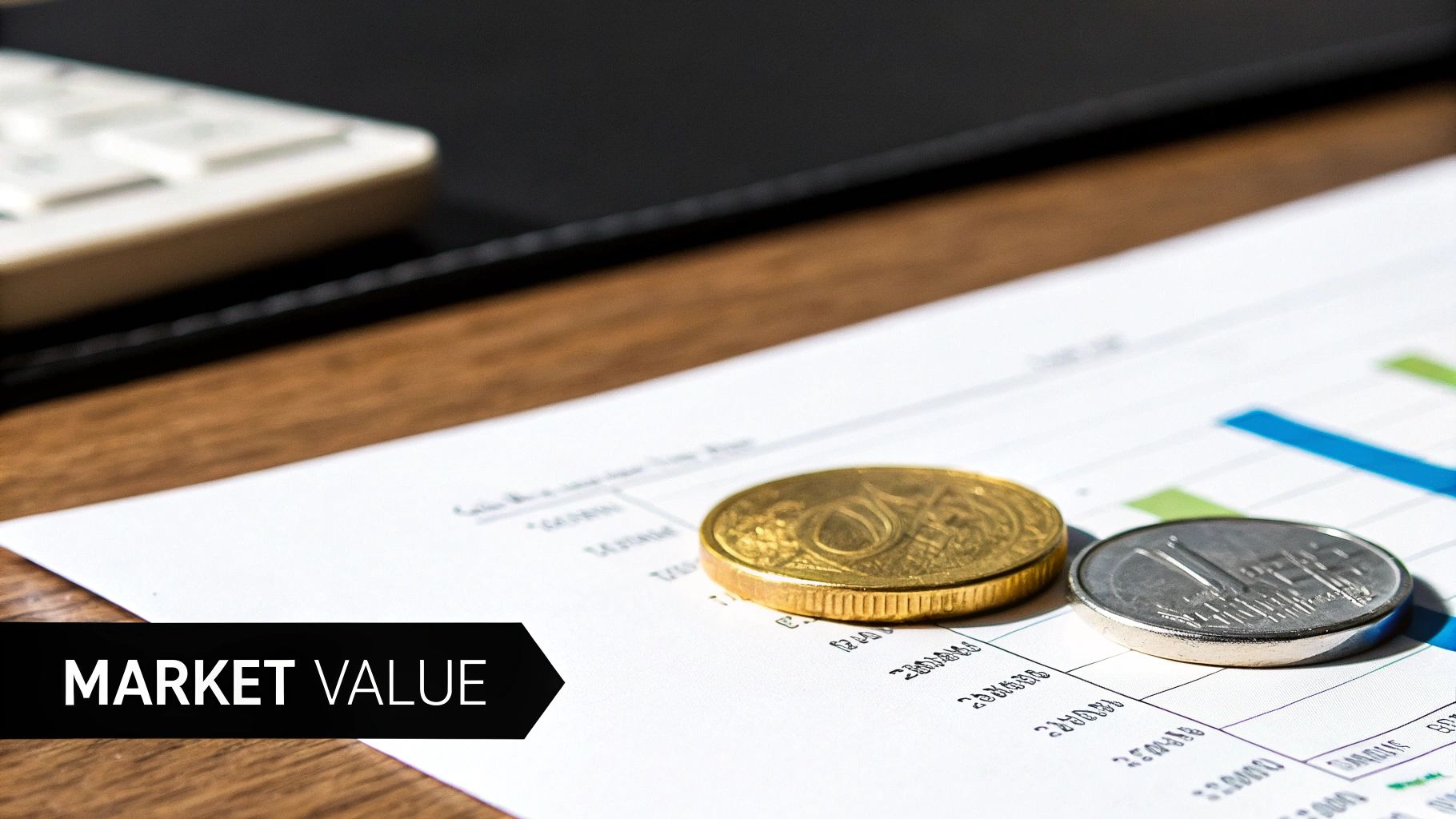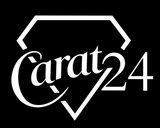Before you pull out any fancy equipment, the most important tools you have are your own two eyes. A good, hard look at a piece is the first thing any expert does, and honestly, it can often tell you everything you need to know right then and there. This initial once-over helps you spot the obvious signs of a real or fake piece and decide if you even need to bother with more complex tests.
Your First Clue: Visual Inspection for Gold and Silver
So, what are you looking for? The first thing is to hunt for any hallmarks or purity stamps. These are tiny engravings usually tucked away in a discreet spot, like the clasp of a necklace, inside a ring's band, or on the back of a pendant.

You’ll probably need a magnifying glass or a jeweler's loupe to see them clearly, but they are your best first clue.
Identifying Key Markings
These little stamps are like a cheat sheet for the metal's purity. Authentic gold and silver pieces are almost always marked to show their precious metal content.
A quick reference can make all the difference when you're trying to decipher these tiny engravings. Here are some of the most common hallmarks you’ll encounter on pieces from the US and Europe.
Common Hallmarks on Gold and Silver Jewelry
| Metal | Common Purity Stamp (USA) | Common Purity Stamp (Europe) | Meaning |
|---|---|---|---|
| Gold | 10K, 14K, 18K, 22K | 417, 585, 750, 916 | The karat or fineness of the gold. 14K is the same as 585, meaning 58.5% pure gold. |
| Silver | 925, STERLING, STER | 925, 800 | The purity of the silver. 925 indicates the piece is 92.5% pure silver, also known as sterling silver. |
| Platinum | PLAT, PT950 | 950 | The piece is 95% pure platinum. |
The style of these stamps can also give away a piece's origin. For example, Italian gold often has unique maker's marks alongside the purity stamp, which adds another layer to its story. Knowing these regional differences can give you more context on what to look for.
Spotting Signs of Fakes
Beyond the official stamps, you need to play detective and look at the item's overall condition. Pay close attention to the edges and any areas that would get a lot of wear and tear.
The most obvious red flag is discoloration. If you see a different color metal peeking through—usually a reddish or grayish tone—you're almost certainly looking at a plated item, not solid gold or silver.
Think about it: real, solid precious metals won't have a different material underneath. If the top layer is flaking or rubbing off to reveal something else, that’s your answer right there.
Also, be suspicious of any jewelry that leaves green or black marks on your skin. This is a classic reaction to base metals like copper or nickel, which are often used in fakes. While it's not a foolproof gold silver test, it’s a pretty strong sign that the piece isn't what it claims to be.
Simple At-Home Tests You Can Trust
After you've given your piece a good once-over visually, it's time to roll up your sleeves and try a few simple, non-destructive tests. The best part? You probably have everything you need lying around the house. These methods are surprisingly good for a quick gold silver test and can help you weed out a lot of the common fakes right away, all without risking any damage to your items.
The Magnet Test: An Easy First Step
One of the quickest and most telling tests is the Magnet Test. Real gold and silver are not magnetic. It's that simple.
Grab a strong magnet—a good quality refrigerator magnet or one from a hardware store will do—and hold it right up to your jewelry or coin. If you feel any pull at all, even a slight one, you're almost certainly dealing with a fake. That magnetic attraction is a dead giveaway for ferrous metals like iron or nickel, which are cheap core materials often plated with a thin layer of gold or silver.
Listening for Authenticity with the Ping Test
Here's a fascinating old-school trick that works wonders, especially for coins and bullion. It’s called the "Ping Test," and it’s all about sound. Genuine silver and gold have a unique density that creates a beautiful, clear, ringing sound when gently struck.
To do this one safely, just balance the coin on the tip of your finger and tap it lightly with another coin. Listen closely.
- Real Silver or Gold: You'll hear a distinct, high-pitched, bell-like ring that lasts for a second or two. It's a clean, resonant sound.
- Base Metals: Fakes made from stuff like copper, zinc, or nickel will just give you a dull, short "thud." There’s no real resonance, no music to it.
The difference might seem subtle at first, but once you hear the crisp ring of a genuine precious metal coin, the dead sound of a fake becomes incredibly obvious. A great way to train your ear is to practice with a coin you know is legit, like a U.S. quarter minted before 1965. For a deeper dive into other tell-tale signs of counterfeits, our guide on how to identify fake gold has more great visual cues and expert tips.
The Limits of DIY Testing
While these at-home tests are fantastic for an initial screening, they aren't foolproof. Some of the more sophisticated fakes are now made with non-magnetic base metals specifically to beat the magnet test. That's why, when you need a 100% certain answer, nothing beats getting a professional opinion.
When you're ready to sell, the ultimate peace of mind comes from an expert assessment. At a trusted local buyer in Boise, you can get free Xray Scanning and Gold Testing for a precise, hassle-free offer, ensuring you get the highest payout without the risk of online shipments.
Professional equipment can see things our eyes and ears can't, confirming the exact purity and value of your items down to the decimal. By starting with these easy at-home methods first, you can build confidence in what you have before you take the next step and explore a professional gold silver test.
Advanced Testing: From Acid Kits to XRF Scans
When the at-home methods leave you with questions and you need absolute certainty, it's time to pull out the tools the professionals rely on. These methods go far beyond a simple visual check or magnet test, giving you a deep analysis that confirms the exact composition of your items.
The most classic of these techniques is the acid scratch test. For decades, this has been a cornerstone for anyone in the Gold and Jewelry Buying industry. It’s a hands-on process. You carefully scratch the item on a special slab called a touchstone, which leaves a small streak of the metal. From there, you apply different acid solutions that are calibrated for specific karats, like 10K, 14K, or 18K. How that metal streak reacts—or more importantly, doesn't react—tells you its purity. For a really in-depth look at this old-school method, you can check out our detailed guide on how to test gold purity.
The Rise of Modern Testing Technology
While the acid test is effective, it requires a skilled hand and, by its nature, is slightly destructive. That’s why modern technology has stepped in with faster and completely non-damaging alternatives.
Electronic gold testers, for example, have become quite popular for quick assessments. They work by measuring the electrical conductivity of an item to estimate its karat value. They're a lot faster and certainly less messy than breaking out an acid kit.
But even electronic testers have their limits. Today, the true gold standard in the precious metals industry is X-Ray Fluorescence, better known as XRF scanning. An XRF analyzer shoots x-rays into a metal sample, which excites the atoms and causes them to release a unique energy signature. The machine reads these signatures instantly, providing a precise elemental breakdown of the item without leaving so much as a scratch.
The infographic below shows how the simpler, initial tests often come before bringing in these more advanced methods.

This flow is a great illustration of how you can use preliminary, non-invasive checks to weed out the obvious fakes before moving on to a definitive analysis like XRF.
Why XRF is the Professional's Choice
The real beauty of an XRF gold silver test is that it's completely non-destructive and incredibly accurate. There are no chemicals, no scratching, and zero guesswork. It can detect gold, silver, and platinum, and even identify unwanted filler metals like nickel or lead. This level of precision is exactly why it's the preferred method for anyone serious about verification.
When you want to sell your valuables, this technology is your best friend. It guarantees you are getting paid for the exact amount of precious metal you have. This is why it is essential to save the hassle and sell locally for more than online shipments.
For Boise residents, this advanced technology is right at your fingertips. By choosing a local buyer who provides free Xray Scanning and Gold Testing, you get access to this professional-grade analysis without any cost. This service ensures you get a transparent, hassle-free offer and the confidence that you’re receiving the highest payout in Boise. And with the added benefit of Price Matching, you can be absolutely sure you're getting the best possible value for your gold and silver.
Why Selling Locally in Boise Offers the Best Payout
While at-home tests are a fantastic way to satisfy your own curiosity, they can only get you so far. When you’re ready to actually sell, getting a professional, spot-on evaluation is the only way to guarantee you’re getting the true value for your gold and silver.
This is where the how of selling becomes just as critical as the what you’re selling. Many people are tempted by online mail-in services, but that route is often paved with hidden risks and lower payouts. Think about it: you have to pack up your irreplaceable valuables, ship them off to a faceless company, and just wait for an offer you have almost no power to negotiate. It’s a stressful process that rarely ends in your favor.
The Security of a Face-to-Face Transaction
Opting for a trusted local expert for your Gold and Jewelry Buying needs wipes all those uncertainties away. When you walk into a reputable shop here in Boise, you get a secure, transparent, and immediate experience.
You never lose sight of your items. You can ask questions, watch the entire evaluation process, and get a feel for who you're dealing with. That direct interaction builds confidence and makes sure you're treated fairly from start to finish. There's no anxiety over lost packages or waiting days for a lowball email—just a straightforward, hassle-free offer right on the spot.
Selling locally means you save the hassle and sell for more than online shipments. The peace of mind that comes from a face-to-face transaction with an expert is invaluable, ensuring both your security and a better financial outcome.
This direct approach is especially important when you're dealing with pieces that have high monetary or sentimental value.
Advanced Technology and the Highest Payout in Boise
Honestly, the biggest advantage of selling in person is getting free access to professional-grade equipment. The best buyers in Boise provide free Xray Scanning and Gold Testing, using the same XRF technology we covered earlier. This professional gold silver test delivers a precise, non-destructive analysis of your items' exact metal content.
That level of transparency ensures your offer is based on hard data, not just an educated guess. It puts you in the driver's seat, allowing you to make a decision with all the facts laid out in front of you. When a buyer invests in this kind of tech, it’s a huge sign of their commitment to fairness and accuracy. If you're weighing your options, our guide on finding the best place to sell gold digs deeper into what you should look for in a buyer you can trust.
On top of that, the top local experts are so confident in their pricing they even offer Price Matching. This is your guarantee that you will always get the highest payout in Boise. By sidestepping shipping fees, insurance costs, and the risk of a weak online offer, you don't just simplify the process—you walk away with more cash in your pocket. Selling locally is simply the smartest, safest, and most profitable way to turn your precious metals into immediate cash.
Understanding Your Jewelry's Market Value

Knowing the purity of your items after a gold silver test is a huge step, but it’s only half the story. To really get a handle on what your jewelry is worth, you need to understand the bigger picture—the fascinating push-and-pull between gold and silver in the market.
We often measure this relationship using the gold-to-silver ratio. It’s a simple concept: how many ounces of silver does it take to buy one ounce of gold? But this isn't just some random number; it's a powerful indicator of economic trends and investor confidence.
Historically, this ratio has been all over the map. Governments once fixed it to keep their money stable—the Roman Empire set it at 12:1, and the U.S. Coinage Act of 1792 locked it in at 15:1. Today, it’s a free-for-all, floating entirely on market demand. You can dive deeper into how equity volatility impacts this ratio at datatrekresearch.com.
What the Ratio Tells You About Value
So, what does this number actually mean for you? When the ratio is high, gold is way more expensive than silver compared to their historical average. This usually signals economic jitters, as investors pile into gold, the ultimate safe-haven asset.
On the flip side, a lower ratio might mean silver is gaining ground or is undervalued compared to gold. Keeping an eye on these trends gives you crucial context for your own precious metals. It helps explain why the payout for a gold piece can feel so much higher than for a silver item of the same weight.
Understanding market conditions empowers you during a sale. It transforms your transaction from a simple exchange into an informed financial decision, ensuring you get a fair price based on current realities.
This knowledge is your best tool when you’re ready to sell. It lets you have a real conversation with a potential buyer because you understand the ‘why’ behind the offer they’re making.
Turning Knowledge into the Highest Payout in Boise
At the end of the day, all this market insight comes down to one thing: getting the best possible price for your items. While you can track ratios and spot prices online, the most direct route to a great payout is to work with a trusted local expert.
Local Gold and Jewelry Buying services in Boise give you immediate, hassle-free offers based on live market prices. You can save the hassle and sell locally for more than online shipments, steering clear of the risks and delays that come with mailing your valuables. With services like free Xray Scanning and Gold Testing, you get a transparent valuation backed by solid technology.
For a clearer picture of how purity, weight, and spot prices all come together to create an offer, it helps to see the full calculation. You can learn more about this process in our guide that explains what is my gold worth. This foundation, combined with a reputable buyer offering Price Matching, is your guarantee that you’ll receive the highest payout in Boise.
Common Questions About Gold and Silver Testing
As you dive into the world of precious metals, a lot of questions pop up. After walking through everything from simple visual checks to professional-grade tech, we've pulled together the most common things people ask to give you clear, straight-to-the-point answers for your own gold silver test.
Can I Test Jewelry At Home Without Damaging It?
Yes, you absolutely can. The safest methods you can do at home are completely non-destructive, so you can breathe easy.
A careful visual inspection, the trusty magnet test, and even the sound-based "ping" test are all fantastic first steps. They won't harm your items in any way and can quickly weed out most common fakes without any chemicals or scratching. While an acid test gives you a more concrete answer, it does come with a small risk of damage—which is exactly why the pros use non-destructive X-ray scanning for truly valuable pieces.
What Is The Most Accurate Way To Test Gold And Silver?
Without a doubt, X-Ray Fluorescence (XRF) scanning is the gold standard. It's the most accurate and reliable method available today, period.
An XRF analyzer gives you a precise, instant chemical breakdown of an item, confirming its exact purity right down to the decimal point. It’s a completely non-destructive process that offers definitive results with zero risk to your valuables. That’s why it has become the clear industry standard for any serious Gold and Jewelry Buying business.
Why Is Selling Gold Locally In Boise Better Than Online?
When you sell locally here in Boise, you get transparency, security, and immediate payment. It’s as simple as that.
You get a face-to-face transaction with an expert, a hassle-free offer, and often the highest payout in Boise. There’s no risk of your precious items getting lost or damaged in transit, and you avoid the long delays that often come with mailing things off to an online buyer. Reputable local buyers in Boise also provide free Xray Scanning and Gold Testing and even offer Price Matching. This ensures you save the hassle and sell locally for more than online shipments.
How Does The Gold-To-Silver Ratio Affect My Payout?
Think of the ratio as a snapshot of the market's mood—it shows how gold is valued relative to silver at any given moment. While buyers always base their offers on the live spot price of your specific metal, understanding the ratio gives you valuable context.
Since the year 2000, gold and silver prices have shown a mostly positive correlation, though gold often performs better during times of economic uncertainty. You can dig into how the ratio reflects market sentiment over at Longtermtrends.net.
Ultimately, a high ratio signals a strong gold market, but it doesn't directly change your immediate cash offer. That number is always calculated based on three things: purity, weight, and the live spot price of your metal.
Ready to discover the true value of your precious metals with a trusted, professional evaluation? At Carat 24 - Trusted Gold Experts, we offer free, state-of-the-art XRF analysis and the highest payouts in Boise. Visit us today for a transparent, no-obligation offer at https://carat24boise.com.


